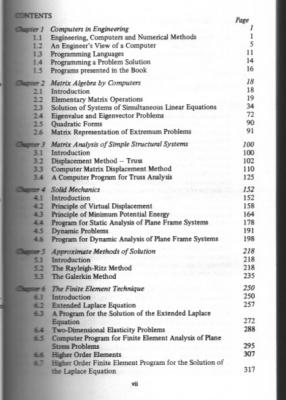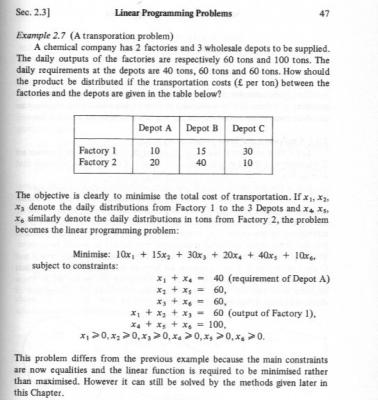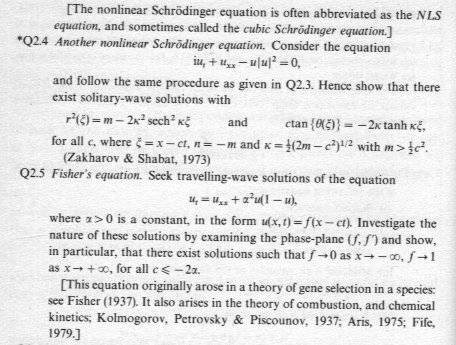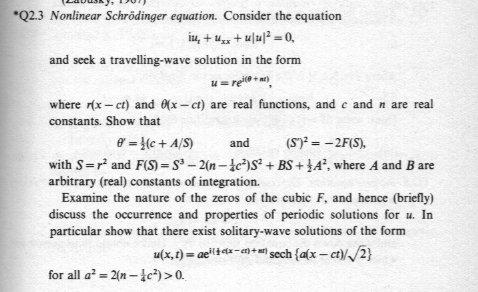-
Posts
18485 -
Joined
-
Last visited
-
Days Won
108
Content Type
Profiles
Forums
Events
Everything posted by studiot
-

Is logic a branch of philosophy or maths?
studiot replied to andrewcellini's topic in General Philosophy
Please don't close it yet. I am still waiting for next week's lotto numbers. -
More than 100 views over the 1000 on this thread, yet no one else seems to have anything to say? I am sorry you could not locate the books locally, part of the reason I mentioned them is that they readily are availble secondhand at reasonable prices from international online supplies such as abe. I would council against avoiding examples until the end. Numerical mathematics is an enormous subject and trying to learn all the theory before application is about the most difficult way I can imagine. The example I offered take no more than 5 minutes and the back of a small envelope to figure out. But it does provided the opportunity to discuss many of the principles underlying numerical techniques without difficult numbers getting in the way. Incidentally it is always a good idea to try out a technique on a known easy example. The posh word for this is calibration and is one of the subject areas missing from your list. Talking of lists, yours seems largely to be a list of methods or techniques and I have to tell you that it is far from complete. The old fashioned (I called it standard before) presentation of numerical methods was just this an ever growing list of methods and techniques. An alternative is to divide into subject areas, here is the contents page from the book by Brebbia "Computational Methods of Solution of Engineering Problems". You will note that almost nothing here is on your list. Yet even Brebbia's list is far from complete. Some further subject areas include Optimisation Maximum and Minimum problems Variational methods. Numerical transform methods Numerical Harmonic analysis Potential Theory Exploiting the link between boundary and body elements using numerical versions of Green's and Gauss' theorems, Linear programming Non linear programming Computational Efficiency and Accuracy and Error Theory. Here is another problem for an accountant to ponder.
-

Cardinality of the set of binary-expressed real numbers
studiot replied to pengkuan's topic in Mathematics
To answer this you need to go back to your definition of countable and countably infinite. -
Why do you guys have to have such long handles to type in? I can't agree with this. Since you like lists here are a few major discoveries/breakthroughs that were not borne in such strife. Ut pendet continuum flexile, sic stabit contiguum rigidum inversum The discovery of penecillin The discovery of the vulcanisation of rubber Probably the discovery of how to make fire Your stout defence of the good name of scientists in general is fine but sadly misplaced in certain individual cases. Berzelius suppressed the development of Chemistry for at least half a century. The denial of Bayesian statistics by Pearson and Fisher and its resulting suppression for nearly a century.
-

Cardinality of the set of binary-expressed real numbers
studiot replied to pengkuan's topic in Mathematics
One thing to remember in what you are attempting is the difference between fractions and rational numbers. A fraction, say 2/3 is different from the fraction 40/60. In fact there are infinitely many fractions with that same value. But they all represent the same rational number, because the rational number is an equivalence relation that forms a proper partition of the set, indifidual fractions are not. I have not studied the effect of this in binary (or any other base for that matter), but I am sure it will be present. -
Thank you phi for researching the origin and history of the phrase, that is all new to me. It would seem that there are those who find its use distasteful and those who consider it a badge of honour. There is therefore an obvious potential for misunderstanding its usage. As a child of the 50s and 60s I would place myself in the badge of honour camp; it is the only version I have ever known. I have always thought of the usage to be particularly for situations when there would normally be a conventional solution but some additional (new) constraint is acting to prevent or obstruct success. These constraints may be financial, physical, artificial or whatever. This interpretation would exclude genuine new inventions or discoveries. I think perhaps 'blue sky thinking' is more appropriate to these activities. Further my interpretation makes no distinction or stipulation as to the level of expertise of the intitiator. As examples I offer The use of empty oils drums by the financially constrained British to assess blast damage from nuclear tests. The creation of new oil replacement chemical technology by the Germans in WWII, and later the South Africans when under embargo; both were starved of oil. Columbus reaching America going west trying to reach China when the silk road was closed to him.
-

Cardinality of the set of binary-expressed real numbers
studiot replied to pengkuan's topic in Mathematics
As I understand the reasoning Every decimal number of length (after the point) n can be expressed as a fraction by adding n zeros to 1 on the bottom. In other words the cardinality of the decimals is the same as that of the rationals. But there are real numbers which are irrational. That is they cannot be expressed as a rational fraction. So there are additional real numbers that cannot be paired with a rational so there are more real numbers than rational numbers. So the cardinality of the reals is greater than that of the rationals. -

Cardinality of the set of binary-expressed real numbers
studiot replied to pengkuan's topic in Mathematics
Easy there. There are real numbers that cannot be expressed in decimal. There are different real numbers that cannot be expressed in binary. Decimal numbers are (i think) countable, but real numbers are not. https://en.wikipedia.org/wiki/Irrational_number You need the Schroeder Bernstein theorem to compare cardinality of these infinite sets. https://www.google.co.uk/search?q=schroeder+bernstein+theorem&hl=en-GB&biw=&bih=&gbv=2&oq=schroeder+ber&gs_l=heirloom-serp.1.0.0l4j0i22i30l6.2735.7485.0.9953.13.13.0.0.0.0.172.1735.0j13.13.0....0...1ac.1.34.heirloom-serp..0.13.1735.P-9FaKSEh3w -
Well I don't agree with this discussion about the box, or the sanction of DevilSolution for discussing it further, although it is off topic. +1 If folks really wnat to debate 'thinking ouside the box' then it should be in a separate thread. This one is about Newton and gravity. My answer is By the standards and knowledge of his day, Newton was not wrong. If we applied modern statistical techniques to the data known at the time of Newton's gravitational hypothesis it would support his hypothesis to a high degree of confidence. He was, however, troubled about the concept of 'action at a distance', but observed that his hypothesis fitted the known facts and could be extended to make predictions that were then verified. In my view, Newton was the greatest scientifc genius ever and his theory of gravity was ideally suited to the knowledge of mechanics available in his day.
-
Did you have a real question amongst all that rambling? Because if you did you hid it too well for me to find.
-
You haven't said whether this is in relation to school or college/university. There is a big difference. At school you have to (are supposed to) learn everything about all the subjects. Further the syllabuses are specified in great detail. You are not expected to know things they haven't told you, or work out for yourself the important key points. The key to school success is practice, practice, practice. But take heed of the words of others here about lengths of individual sessions and breaks. At uni you can't learn everything about a much more narrow subject. Not only do you specialise but each college includes or omits different material and their syllabuses are much briefer, more general and more loosely defined. Further they are expecting you to begin to think for yourself so everything is not spelled out in excruciating detail. So it is important to pay particular attention to the material presented and extract the key points. You study should include some fill-in and extension or reading round the subject. Discussion with your peers is always good. Unless you have started taking kryptonite pills you should still take heed of the words of others here about lengths of individual sessions and breaks. Go well in your studies.
-
It is Christmas after all. +1
-
Thanks, imatfaal, it's the internet stuff that's mostly way over my head. If it's possible to b____r it up, netwise, I have found the way. Three further references. Firstly J E Marsden and J R Hughes (Marsden seems to pop up a lot in higher level applied maths) Mathematical Foundations of Elasticity Has a good deal about non linear dynamics and you semi linear Schrondinger equation, in the chapter on functional analysis. Avery Modern book Material Inhomogeneities in Elasticity Gerrard Maugin analysis various NLS equations quite deeply, including numerical emthods. And boasts an extensive modern reference list. Finally also look at Philippe Boulanger and Michael Hayes Bivectors and Waves in Mechanics and Optics.
-
I have just realised that your link allows access to the paper, I do not normally have access to arxiv papers. So I am still trying to understand what exactly you are looing for. Have you looked in Drazin and Johnson Solitons Cambridge University Press? Here are a couple of examples As regards the Hamilton approach, have you looked in Sewell Maximum and Minimum Principles Both these books are from the Cambridge University series in advanced applied maths.
-
Yes that's a correct definiton of linear independence, which is the underlying requirement behinf systems of linear equations. You have a vector of 'basis' variables premultiplied by a matix of coefficients (constants) equaling a vector of results. You need to be able to invert the matrix to solve thsystem. If the matrix is not invertible the system is insoluble and its determinant is zero. The basis functions must be linearly independent, that is one cannot affect the other so not only are cross functions excluded but also linear combinations where x = (say) 3y. Working all this out for yourself is laudible, but doing it the hard way. Try a good book, like the one by Howard Anton Elementary Linear Algebra
-

Bernoulli Principle - blood flow
studiot replied to jsmith613's topic in Anatomy, Physiology and Neuroscience
Interesting, I didn't know that the blood vessels changed diameter appreciably during the pumping cycle. By comparison, canvas hozes do not stretch appreciably even under fire hose pressures. What happens to the surrounding tissue when they expand or contract? -
Are you looking at envelope-soliton or perturbation solutions to the NLS? googling the former even brings up MAtlab code https://www.google.co.uk/search?hl=en-GB&source=hp&biw=&bih=&q=envelope-soliton+solution+of+NLS+equation&gbv=2&oq=envelope-soliton+solution+of+NLS+equation&gs_l=heirloom-hp.3...1281.21203.0.21547.41.16.0.25.2.0.187.2095.0j16.16.0....0...1ac.1.34.heirloom-hp..24.17.2048.vG4e-ILW9QU
-

Bernoulli Principle - blood flow
studiot replied to jsmith613's topic in Anatomy, Physiology and Neuroscience
The best way to look at it mechanically is the statement Fluid tries to flow from high pressure to low pressure. But pressure in Pascals is not a useful measure, since not all processes can be measured in Pascals. Bernoulli offers a way to overcome this by using a term known as 'head' or pressure head. All the processes, standing pressure of the fluid, the kinetic energy of the fluid, the resistance to flow of the pipework, the energy injected by pumps can be expressed in terms of pressure head (measured as a length or distance) and thus compared and accoutned for. I do not think the gravitational variation is significant or even measurable (although it too can be expressed as a head) in human circulatory systems. -

Bernoulli Principle - blood flow
studiot replied to jsmith613's topic in Anatomy, Physiology and Neuroscience
I don't know where you read either of those equations but I would suggest looking for some better books that explain themselves properly. Bernoulli's equation does not apply directly to blood vessels since there is significant resistance to flow (an energy dissipative process) and Bernoulli is a conservation equation. In some instances a modification to Bernoulli is possible where an extra term is introduced to model this dissipative loss. This may be the reason for the negative in your second equation. A second process is also present in blood circulation. The pumping process. Pumps, like resistance, are modelled in Bernoulli by introducing extra terms. The circulation pressure component of Bernoulli is not constant, but varies during the pumping cycle. So it depends what is meant by the 'pressure'. A mean pressure,as a function of the systolic and diastolic pressures is defined. https://en.wikipedia.org/wiki/Blood_pressure -
What happens if you hit a liquid with a hammer?
-
Two posts and we are no clearer what you want to achieve. When you say under impact, what do you mean change colour? Do you mean just during the impact? Does it have to maintain the new colour after imapct? Or should it revert to its old colour after the very short term impact forces have dissipated? Can it be a contraption rather than a material? Why impact? What about sustained pressure? Or what about tension? Soap films go through dramatic colour changes as the tension varies.
-
First off let me point out that most glass surfaces/interfaces with the rest of the world are not sharp they are smooth. For example the surface of a window pane or light bulb. However glass also has significant locked in residual stresses. These make it quite unlike a metal lattice which is basically in equilibrium. The glass structure is more like a taught bow, with significant energy available if the string is released. https://www.google.co.uk/search?hl=en-GB&source=hp&biw=&bih=&q=residual+stresses+in+glass&gbv=2&oq=residual+stresses+in+glass&gs_l=heirloom-hp.3...688.11641.0.11938.26.15.0.9.9.0.265.1718.0j9j2.11.0....0...1ac.1.34.heirloom-hp..11.15.1922.ucBFGoQkFeY Traditional stress relieving techniques like anealing do not work fully with glass. Glass is subject to a particular form of brittle failure known as fast fracture. This is exacerbated by the residual stress energy, which promotes rapid and catastophic crack propagation once initiated, because of the available residual stress energy. The shortest distance between two points in the engineering world is a straight line, so straight cracks with angular (sharp) edges form preferentially over other shapes. http://ocw.mit.edu/courses/materials-science-and-engineering/3-11-mechanics-of-materials-fall-1999/modules/frac.pdf Does this help?
-

Does mathematics really exist in nature or not?
studiot replied to seriously disabled's topic in General Philosophy
Indeed we can agree on that. But I need to finish my supper, would you believe it - a bowl of dead friyut, otherwise known to the English as stewed fruit (and custard). On that note I also think it is time to call time on this thread.





